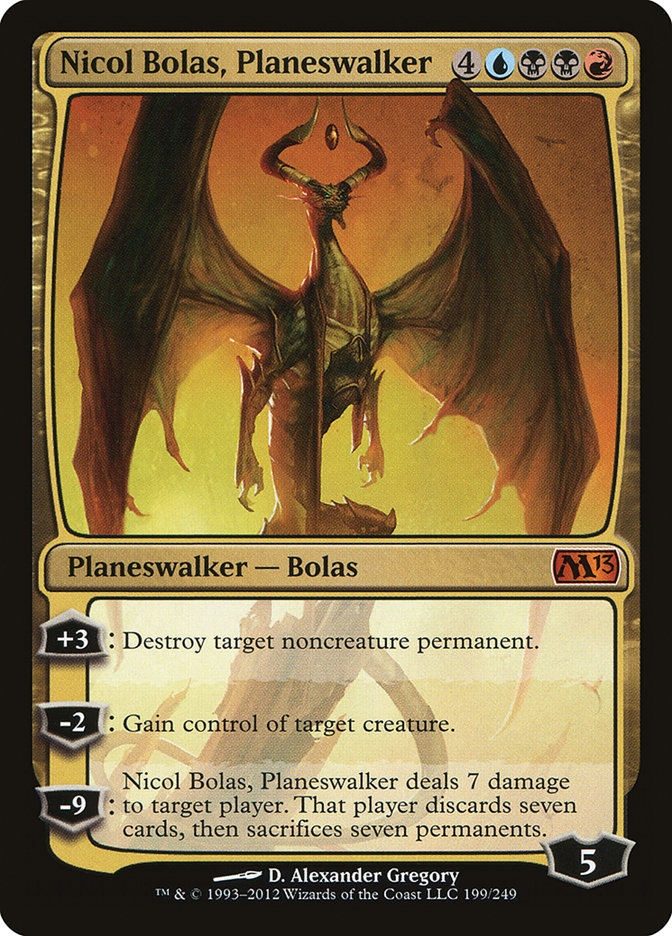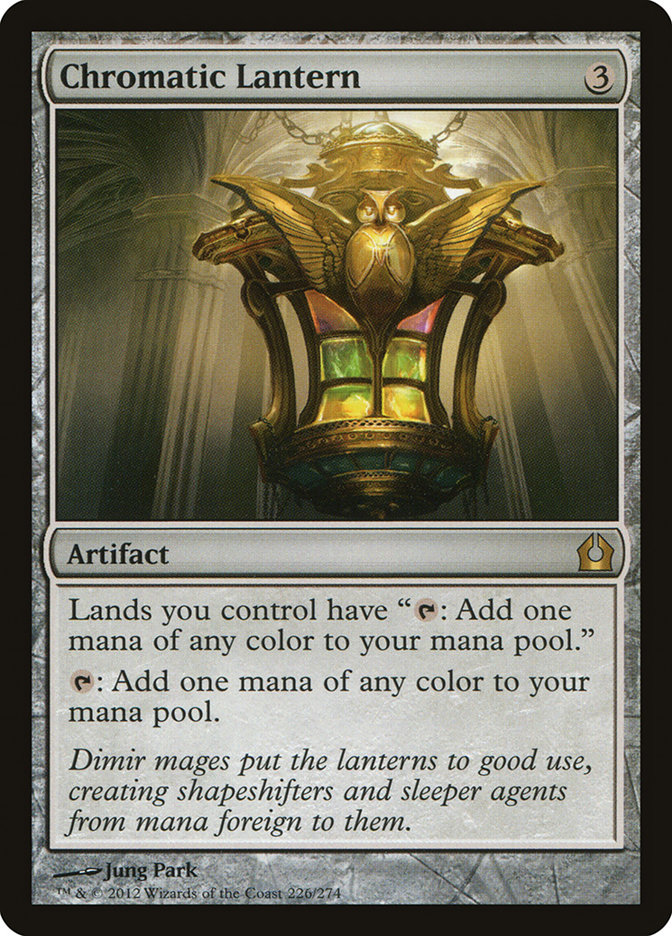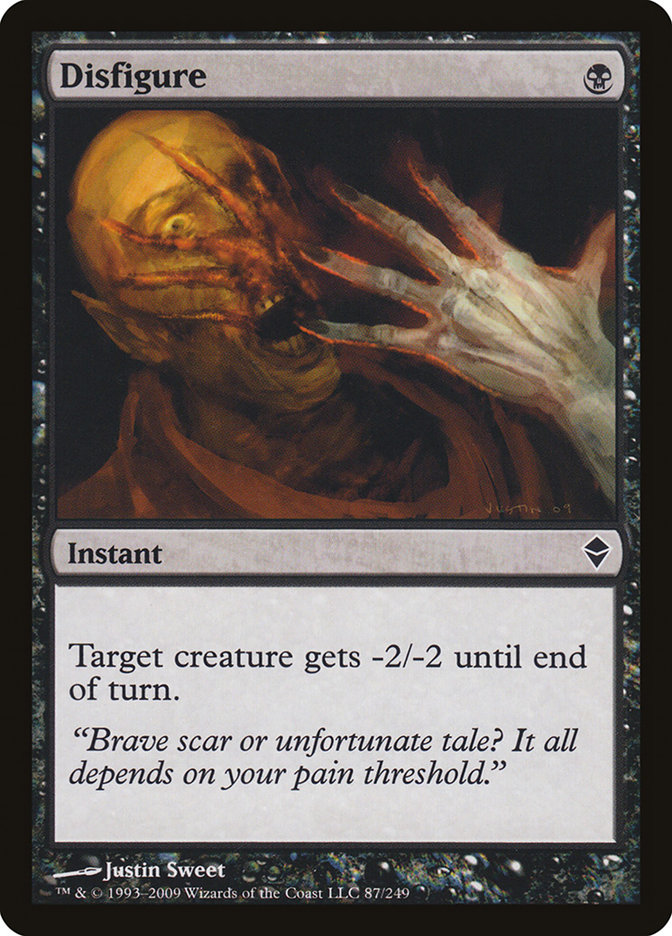Being on the splash has been popular lately; cards like Burning Earth, red’s general aggression, and a general cultural departure from convoluted mana bases and labyrinthine land sequencing. Few three-plus color decks exist that don’t have significant life-gain and control elements. In a sense, I think this is more what Magic should be about; committing to one or two colors and allowing yourself to come up with creative ways of handling what your colors are not usually good at handling. People are turning to artifacts like Ratchet Bomb to shore up awkward permanent issues, Pithing Needle to stop planeswalkers and lands, and Glaring Spotlight to let you jab at your opponents’ Aura-laden targets or sneak your team by for one turn. A lot of decks really do favor one color now, opting to include a small amount of cards from another color to keep the bases smooth.
As I said, I think this is a good shift, but I also see it as an opportunity.
While the Standard format has been dominated by Hellriders, Thragtusks, and Desecration Demons lately, many have set the most powerful spells in Standard aside in the name of consistency and reliability. It’s easier to cast Desecration Demon than, say, Supreme Verdict.
As I’ve watched this paradigm shift, I’ve considered something. Yes, it’s greedy, but fun ideas usually are.
Could . . . could I have both?
Magic is designed in such a way that the more colors you add to your deck, the more complicated and more powerful your deck can become. This is one of many signs of Magic’s sturdy design, but there is a card that lets us manipulate that nearly absolute rule.
With a Lantern to guide you, you’re no longer limited by the colors of mana. You aren’t inhibited by your land placement or the level of non-color producing lands you control. You’re free, man. Free as a bird.
Today, I have two decks that I’ll call "impostor" decks, i.e. decks that cast things not normally associated with their color while maintaining the appearance of a deck locked into its own slice of the color pie. When building an impostor deck, where land color doesn’t really matter, it’s important to make a good base. Until you get your Prismatic Omen, Joiner Adept, or Chromatic Lantern online, you don’t want to have a ton of cards that you cannot cast. Since black has efficient removal, conditional draw, and "basic lands matter" flavor, I decided to make the first impostor deck black. Using the best cards available to us, let’s build a simple, consistent black shell and sprinkle in Standard’s best cards.
Spells (31)
- 3 Darksteel Ingot
- 4 Mutilate
- 3 Corrupt
- 4 Sign in Blood
- 3 Curse of Death's Hold
- 4 Victim of Night
- 2 Boundless Realms
- 2 Rakdos's Return
- 4 Chromatic Lantern
- 2 Sphinx's Revelation
Sideboard

No creatures, but nearly every spell in there has the potential to win you the game by itself.
Mono-Black Suite
Nineteen cards would find a home in any black deck around. Sign in Blood, a very powerful card in the current environment, smoothes out draws, undoes mulligans to six, and can even aim at the face occasionally. Decks like this need to hit pieces on time to stay relevant, and this is an essential player. Victim of Night, better than Doom Blade right now in my opinion, is also cast for no penalty (all black-producing lands) and is often a strict upgrade for Doom Blade in these instances. If you think about it, Doom Blade can kill a Mutavault and Victim of Night can’t, but that’s about it.
Mutilate is still the removal of choice; barring some niche circumstances (Nicol’s -2 and Vraska’s -7,) I won’t have creatures out, so Mutilate is a clean sweep. It’s arguably more powerful and flexible cousin, Supreme Verdict, would be very out of place here. As you’ll notice, all of my removal is black despite the prismatic nature of the deck. I need to be able to reliably thwart aggressive threats while I get my five-color spells ready for action, and making sure I can do that consistently means the difference between X-0 and 0-X. Curse of Death’s Hold, a nice follow-up play on 4 with seven three-mana ramp spells, helps minimize the damage your opponent resolves from later threats. The more the merrier in this case.
Liliana of the Dark Realms, a deliberate choice over little Lili, will thin your deck of Swamps every turn, kill a creature every couple turns, and even go ultimate for a crazy-huge spell. Who doesn’t want to Rakdos’s Return someone for 105? On that note, Corrupt is the most frequent win condition of this deck. Even though you can paint with all the colors of the wind, Corrupt will most frequently be your most reliable source of victory.
Mana Fixers and Land
I’ll do these at the same time. First, seven artifacts highlight the fixing needed of a five-color black deck. You just really have to hit them, so they’re here in exorbitant quantities. They’re not bad in multiples, of course, acting as a second land each turn. Although Chromatic Lantern is almost strictly better (it can still get hit with Abrupt Decay), Darksteel Ingot is surprisingly helpful too. Many of the top-end spells in the deck use only one other color besides black, so an Ingot is sufficient fixing for these instances. Mostly they are here as redundant copies of Chromatic Lantern, but being indestructible has its uses.
Although I fiddled with playing one Swamp shock land of each color, I found that nine times out of ten I just needed a regular untapped Swamp. Liliana of the Dark Realms can act like a repeatable Wanderer’s Twig, but I just never found that it was necessary. If I have a Lantern safely out, there will never be a time that I want a shock land over a basic Swamp. The life loss ended up mattering more than getting the color, so I opted to stick with twenty-five basic Swamps. You can’t get any simpler than that!
The Goodies
In the end, only nine cards are dedicated to the "fun part," but we have to be realistic. I decided to use three impactful control planeswalkers as board managers while I plug away at your dome with player-targeting spells. Boundless Realms is a particularly fun one. The moment you can cast it, you’re likely getting five or six Swamps, and casting another one will clean out the rest of your deck. This means you’ll not only be drawing gas every turn, but the Corrupts you have perched in your hand are now killing machines.
Corrupt on time will deal five or six damage and give you as much life. Hitting them twice as hard and gaining twice as much is just a plane-hopping jump away. The other four X spells also benefit from, well, more mana. Having a lot of mana and a lot of cards is pretty exciting. Have you ever resolved three planeswalkers on one turn? Rakdos’s Return is as useful as ever against a non-blue midrange deck, and it’s a legitimate way to kill someone when you’re pouring double-digit mana into it.
The sideboard is fairly direct. Dead Weight is great on the draw, and on the play you can cast it after resolving one of the mana rocks with the one mana they make. Boy, I miss Disfigure.
If I could just sear your face again . . .
Next, you’ll notice the full set of Slaughter Games. Let’s face it; decks like this have a lot of enemies. Slaughter Games is great at plucking out game-closing threats, but it also serves a more proactive purpose. Tricky decks are very weak to counterspells, and with decks like U/W Control gaining popularity, they are significant enough to worry about. Reach into their brain and extract their Dissipates, Syncopates, or Negates. It’s about the only way to guarantee your battlecruiser spells wouldn’t get swatted away, so I figure they’re a good investment. They’re also great in the Reanimator match, where you can just exile their Angel of Serenity or Thragtusk.
Liliana of the Veil, a great supplement to that third copy of Rakdos’s Return, is still a great lady for doing your dirty work. Hand size for this deck generally varies from topdeck to twelve after Revelationing, so you won’t usually have to worry about tossing something important. Detention Sphere provides an effect that black has almost no access to, letting you deal with resolved noncreature threats.
I diddled around with this deck for a week or so, shifting numbers hither and thither, and I came to the conclusion that it is about as efficient as it’s going to get but that it often still has a problem-making quota. Great hands often involved Swamp, Swamp removal, Swamp removal, Swamp, Rock, Mutilate, topdeck, top deck, topdeck until I hit either the Lantern or Sphinx’s Revelation I needed to turn my deck online. The most exciting matches often involved resolving both Boundless Realms and a twenty-plus Corrupt for the win.
It’s a great choice against midrange and often has the staying power and tempo to contend with big players like Jund and B/W Midrange. Control often forced me to bring in most of the board, and aggro was the same way. I resorted to bringing in Liliana for suboptimal matches, and she did fairly well. Detention Sphere was often irrelevant or uncastable, so I might just option three or four Thragtusks if you’re considering this deck. I like it, though, and if you have these high-value cards lying around and you’re a Timmy like me that likes to see some big numbers, you might want to try it in the dwindling weeks of Innistrad Standard.

A few weeks ago, I got a wild hair to do an Angel tribal deck and piddled around with the newly released Angelic Accord. Well, as you know, Trading Post, one of my favorite Magic cards ever, goes right along with the Accord to give you an Angel a turn, and I decided to pursue the deck fully. This is another zero-creature list that attempts to gain life, make Angels, and beat down. Here’s Miraculous Metal.
Lands (25)
Spells (35)

I won’t go into full detail on Miraculous Metal; suffice it to say there are multiple life-gain outlets, and the goal is to gain four life on both my turns and my opponent’s turns. The Scroll of Avacyn, along with a Mutavault, can give me five life and a chance at a miracle draw on the fly, activating all the deck’s themes, and it’s the main piece of the deck. Seraph Sanctuary also interacts with life gain, and I splash a punch of black for the Vault and sideboarded Slaughter Games, with Darksteel Ingot as my only red source. I built this as shown on Magic Online and ran it through a couple Daily Events after some tests and tweaking.

It was a disaster. Well, at least from a competitive standpoint. The deck itself was super fun and very fulfilling to play for my own style, but despite the tricky, fun synergy and high potential, this deck fell flat on its face in nearly every matchup I tried. It just didn’t have enough power to overwhelm any matchup. It was too inconsistent to deal with aggro reliably, and it was always short on needed cards and resources.
Miracles drove what little success I experienced, including a timely Terminus off a middle-of-combat draw that brought me back from two life against B/G Midrange—that was pretty fun. In general, though, Trading Post won and lost me a lot of games. I needed the Angels, but I also needed the cards in hand, so often I would play incorrectly and would then be faced with an awkward decision the next time I drew a Terminus. Don’t get me wrong, the deck was riotous fun, but after three events and only a couple match wins, I had to shelve it.
One of the main problems I had with this deck involves playing it on Magic Online instead of in paper; in paper, I feel like it would be much more fun and possibly even better. Online, though, one misclick can cost you the game in a technical-intensive match, and nearly everyone’s goal is to make the best deck tickets can buy, so you come across fewer casual decks, especially in tournaments. I derive a lot of my fun from the bizarre looks on people’s faces as the gears in their heads turn when I play some obscure uncommon.
This iteration was the one with which I was the most pleased, but it’s still missing threats and consistency. Most games were won off a healthy Entreat the Angels, and it’s possible that an additional color, blue perhaps, would make it better. What do you guys think? I was excited to play this deck and continued to play it after getting crushed, so I think there’s something there, but who knows; I might have Post-Brain.
The challenge last week, which asked for tribal submissions, did not have nearly as many submissions as the challenges I’ve suggested before; there were not enough to evaluate, so I will not be sharing decks this week. There could be several reasons it was less popular, but being non-Standard might be the main reason. Let’s hop back into the Standard arena and look at a restriction-lifting challenge!
Polychrome Home
Both decks this week utilized spells that they did not naturally have the colors to cast, which made every possibility available. For next week, I want to see what kind of decks you would make if you had perfect mana; no worries about fixing, balance, or shock lands! What crazy decks could you create?
- Format: Standard (Pre-Theros)
- For this challenge, any lands that you use that would produce color are instead lands that have no basic land type and have "T: Add one mana of any color to your mana pool." They are nonbasic lands that you may have any number of in your deck; you can list them as just "Lands." Think of each land as a Command Tower in a Horde of Notions deck or a City of Brass that doesn’t hurt you.
- You may have colorless-producing nonbasic lands in the deck, but they perform as printed (i.e. Mutavault, Gavony Township, and Nephalia Drownyard) and produce only generic mana.
- Sideboards are optional.
- Normal deck and sideboard sizes apply; minimum 60-card maindeck and a maximum fifteen-card sideboard, and no more than four copies of anything besides these special prismatic lands.
- As with each weekly challenge, I will be looking for four things: originality, adherence to the theme, synergy, and playability. While you can certainly pursue a value-fest, I’d encourage you to look for unique opportunities that an open format like this presents. That being said, build what you want to build!
Make sure to get submissions in by Saturday, September 14, 2013 at 11:59 PM PDT so I have time to review them. You can send your submissions to untappedscg@gmail.com. You can submit a deck multiple times, but bear in mind I will only take the most recent submission as your submission for the week. So if you change your mind and submit another deck or tweak a previously submitted one, I’ll only review the most recent email. As usual, I’ll pick a couple of my favorites and share them next week!
Thanks for reading! Theros is coming up fast, and there’s a lot of great potential and flavor to enjoy! We’ll be digging in as soon as the full spoiler is available, and that should be fairly soon. Next week will be my last Standard article with Innistrad cards, so I’ll do my best to make it count. Until then, don’t forget to untap your prismatic lands!
– Matt
CaptainShapiro on Magic Online



